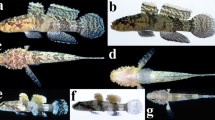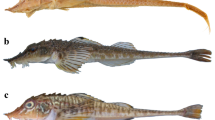Abstract
A new species of parasitic copepod, Octopicola huanghaiensis n. sp., collected from the octopuses Amphioctopus fangsiao (d’Orbigny) and Octopus minor (Sasaki) (Octopoda: Octopodidae) in the Yellow Sea (off Qingdao, Shandong Province, China), is described. The new species is most similar to O. superba Humes, 1957, but can be distinguished from the latter by: (i) the third antennal segment having a different ornamentation; (ii) the fourth antennal segment of females much shorter than that in O. superba (49 vs 94 μm); (iii) males much smaller than females (mean body length 1.3 vs 2.0 mm, respectively) (vs similar male and female body size in O. superba, 1.9 mm and 1.8 mm respectively); and (iv) the presence of a spike at the posterior tip of each labrum flap. Octopicola huanghaiensis n. sp. is the first species of Octopicola Humes, 1957 reported from A. fangsiao and O. minor and is the only species of the family Octopicolidae Humes & Boxshall, 1996 known in North Pacific waters.



Similar content being viewed by others
References
Allcock, A. L., Lindgren, A., & Strugnell, J. M. (2014). The contribution of molecular data to our understanding of cephalopod evolution and systematics: a review. Journal of Natural History, 49, 1–49.
Bocquet, C., & Stock, J. H. (1960). Copépodes parasites d’invertébrés des cotes de la Manche. VII. Sur la présence d’Octopicola superbus Humes, lichomolgide associé a Octopus, le long des cotes de Bretagne. Archives de Zoologie Expérimentale et Générale, 99, 1–7.
Cavaleiro, F. I., Ho, J. S., Iglesias, R., García-Estévez, J. M., & Santos, M. J. (2013). Revisiting the octopicolid copepods (Octopicolidae: Octopicola Humes, 1957): comparative morphology and an updated key to species. Systematic Parasitology, 86, 77–86.
Humes, A. G. (1957). Octopicola superba n. g., n. sp., copépode cyclopoide parasite d’un Octopus de la Méditerranée. Vie et Milieu, 8, 1–8.
Humes, A. G. (1963). Octopicola stocki n. sp. (Copepoda, Cyclopoida), associated with an Octopus in Madagascar. Crustaceana, 5, 271–280.
Humes, A. G. (1974). Octopicola regalis, n. sp. (Copepoda, Cyclopoid, Lichomolgidae) associated with Octopus cyaneus from New Caledonia and Eniwetok Atoll. Bulletin of Marine Science, 24, 76–85.
Humes, A. G., & Stock, J. H. (1972). Preliminary notes on a revision of the Lichomolgidae, cyclopoid copepods mainly associated with marine invertebrates. Bulletin Zoologisch Museum, Universiteit van Amsterdam, 2, 121–133.
Humes, A. G., & Stock, J. H. (1973). A revision of the family Lichomolgidae Kossmann, 1877, cyclopoid copepods mainly associated with marine invertebrates. Washington, DC: Smithsonian Institution.
Humes, A. G., & Boxshall, G. A. (1996). A revision of the lichomologid complex (Copepoda: Poecilostomatoida), with the recognition of six new families. Journal of Natural History, 30, 175–227.
ICZN (2012). International Commission on Zoological Nomenclature: Amendment of articles 8, 9, 10, 21 and 78 of the International Code of Zoological Nomenclature to expand and refine methods of publication. Bulletin of Zoological Nomenclature, 69, 161–169.
Stock, J. H., Humes, A. G., & Gooding, R. U. (1963). Copepoda associated with West Indian invertebrates - IV. The genera Octopicola, Pseudanthessius and Meomicola (Cyclopoida, Lichomolgidae). Studies on the Fauna of Curaçao and Other Caribbean Islands, 18, 1–9.
Acknowledgements
We are grateful to Professor Xiao-Dong Zheng for identifying the cephalopod hosts.
Funding
This study was supported by the National Natural Science Foundation of China (No. 31501842) and the Fundamental Research Funds for the Central Universities (No. 201762017).
Author information
Authors and Affiliations
Corresponding author
Ethics declarations
Conflict of interest
The authors declare that they have no conflict of interest.
Ethical approval
All applicable institutional, national and international guidelines for the care and use of animals were followed.
Additional information
This article was registered in the Official Register of Zoological Nomenclature (ZooBank) as 96E9651E-14E8-4BC4-90BC-72AA1F1F9C30. This article was published as an Online First article on the online publication date shown on this page. The article should be cited by using the doi number. This is the Version of Record.
This article is part of the Topical Collection Arthropoda.
Rights and permissions
About this article
Cite this article
Du, X., Dong, C. & Sun, SC. Octopicola huanghaiensis n. sp. (Copepoda: Cyclopoida: Octopicolidae), a new parasitic copepod of the octopuses Amphioctopus fangsiao (d’Orbigny) and Octopus minor (Sasaki) (Octopoda: Octopodidae) in the Yellow Sea. Syst Parasitol 95, 905–912 (2018). https://doi.org/10.1007/s11230-018-9819-8
Received:
Accepted:
Published:
Issue Date:
DOI: https://doi.org/10.1007/s11230-018-9819-8




